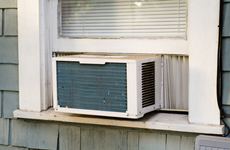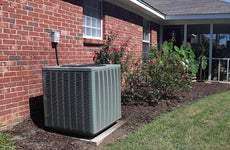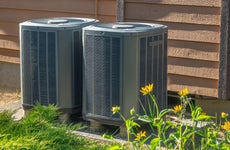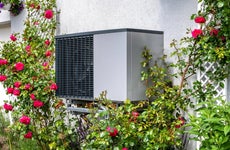What’s a through-the-wall air conditioner?

The Bankrate promise
At Bankrate we strive to help you make smarter financial decisions. While we adhere to strict , this post may contain references to products from our partners. Here's an explanation for .
During the cold of winter, we long for the warm days of summer. But once the temperatures top 75 degrees or so, we head back inside for the cool air delivered by an air conditioner.
But what type of air conditioner is best? If you don’t have central air conditioning, you might consider an individual AC unit, like a through-the-wall air conditioner. Below, we’ll explain how this type of air conditioner works, how much it costs and how it differs from a window AC unit.
What is a through-the-wall air conditioner?
As its name implies, through-the-wall air conditioners are installed into a hole cut into your home’s exterior wall. Most of the unit sits outside your home, but the control panel and vents face inward.
Through-the-wall ACs are a permanent system. Unlike a portable or window AC unit, they don’t get taken out at the end of summer. They can be used as your primary source of AC or can supplement a central air conditioning system. They’re a popular choice for home additions, such as a sunroom or porch. Many of them also have a heating function, making them a perfect option for year-round use.
They range in power from 7,400 to 14,000 BTU (though some can go up to 18,000 BTU) and can effectively cool a room sized from 300 to 800 square feet.
Innovations
Many through-the-wall air conditioners come with a timer that will automatically turn it on and off. Some have a sleep setting that will change the unit’s temperature at night when you’re sleeping. Other features you may find are a quiet mode, a remote control, reminder light to change the filter, a washable filter, automatic shutoff, fan-only option, self-diagnostic tools and overload protection.
The newest units are often “smart” devices, with built-in Wi-Fi so you can control them with an app on your phone. Some have integrated voice-command compatibility so you can operate the unit hands-free.
Pros and cons of through-the-wall air conditioners
Wondering if a through-the-wall AC unit is right for you? Consider these pros and cons.
Pros
- Cheaper than central air conditioning
- Can be installed in one day
- Some can be controlled through a mobile app or have other tech-enabled features
Cons
- Usually require professional installation
- More expensive than a window AC unit
- Limited to a single room
What do through-the-wall ACs cost?
Depending on where you buy it, your through-the-wall AC can cost anywhere from $400 to $2,000. Additionally, through-the-wall ACs require a sleeve to help the wall withstand the weight of the air conditioner without causing damage to the wall. Sleeves can cost an extra $100 to $160.
However, because you need to cut a hole in your exterior wall, installing a through-the-wall AC unit isn’t suited for a casual DIYer. A project of this magnitude could take up to 12 hours to complete, depending on the size of the unit. Installation costs vary, but you can expect to pay roughly $2,100 for parts and labor, according to Angi.
Plus, depending on your home, there may be some additional costs. For one, you may need to have additional electrical wiring completed to handle the load created by your AC unit. Drywall and siding repair may also be required.
Through-the-wall ACs vs window ACs
Because the hole in your wall is cut for the specific size of your air conditioner, these units tend to be more energy-efficient than window air conditioners. With a through-the-wall unit, you don’t have the gaps and leaks you tend to find in the window counterparts.
“Both types can come with varying energy efficiency ratings, but through-the-wall units generally provide a tighter seal against outdoor air, making them often more energy-efficient,” says Josh Mitchell, the founder of Air Conditioner Lab, an HVAC news and reviews website.
“I always advise customers to check the unit’s Energy Efficiency Ratio (EER) or Seasonal Energy Efficiency Ratio (SEER) to make a well-informed decision,” he says.
Additionally, since they’re not sitting in your window, if you have a cooler day, you can turn off your AC unit and easily open the window. Plus, since they’re a permanent fixture, you won’t need to gauge the weather with the calendar to determine the best time to install your unit and take it down for the fall. So, if you’re hit with a late fall heat spell, you can still cool your room.
Through-the-wall AC units also tend to be less noisy than their window counterparts.
With that said, you’ll need to cut a hole in your wall to install a through-the-wall air conditioner. If you live in an apartment building, rent your home or don’t want to hire a professional installer, then a window unit would be a better choice.
So, which type is better — a through-the-wall AC or window AC? One of the main benefits of a through-the-wall air conditioner is you don’t have to set it up and take it down every year. It’s a permanent solution, so once it’s installed, you only need to turn it on or off. If you’re not able to install your window AC every year and instead need to hire someone to do it, you may prefer the permanency of the through-the-wall unit.
Through-the-wall air conditioner units
- More energy-efficient
- Fewer gaps and leaks
- Quieter
- Doesn’t block your window
Window air conditioner units
- Impermanent, so better for rentals or leased properties
- Less expensive
- Easier to install
- Doesn’t require a hole in your wall
The final word on through-the-wall air conditioners
If you own your home and want to explore cooling options beyond central air, through-the-wall air conditioners deserve serious consideration. Their permanency on your home’s exterior wall can give you energy efficient, quiet cooling while allowing you the flexibility of still using your windows. While installing a through-the-wall air conditioner may not be a project for DIYers, you may find it’s worth the cost of paying a pro’s wages, given its other advantages.
Related Articles



